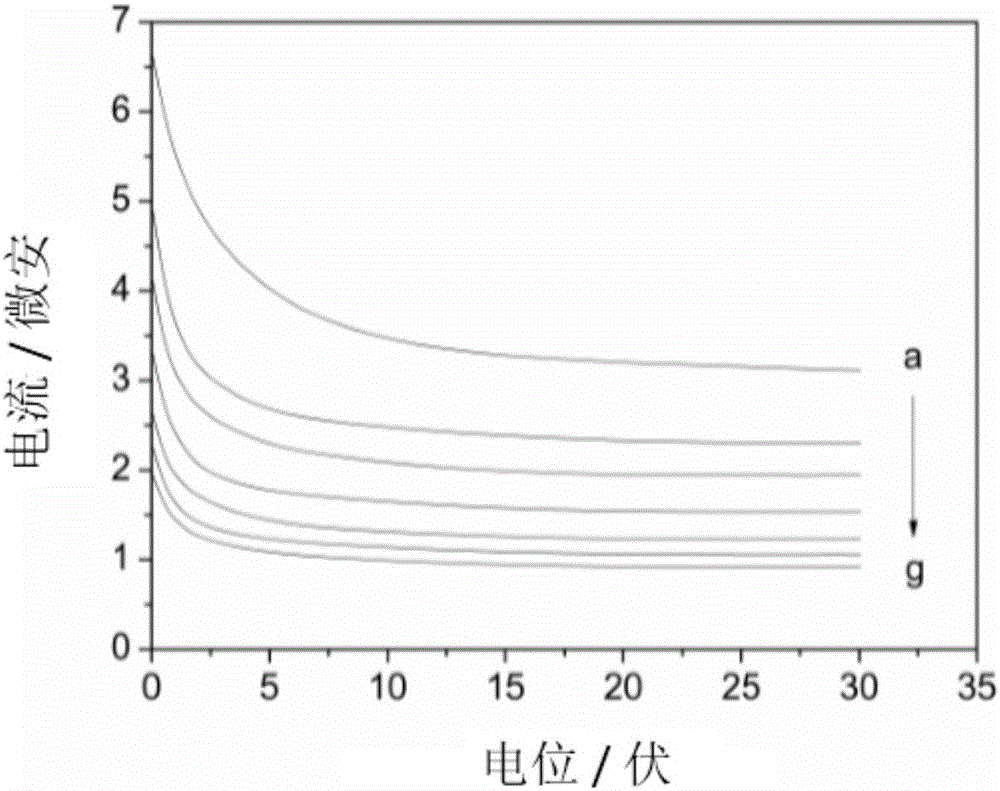Acetylcholinesterase biosensor and application thereof
A technology of acetylcholinesterase and biosensor, which is applied in the field of electrochemical detection, can solve the problems of surface-enhanced Raman spectroscopy, such as poor reproducibility and stability, expensive instruments, and short optical path, and achieve excellent electrocatalytic activity and biocompatibility performance, short detection time, and high sensitivity
- Summary
- Abstract
- Description
- Claims
- Application Information
AI Technical Summary
Problems solved by technology
Method used
Image
Examples
Embodiment 1
[0037] First, prepare Pd-Pt@MnO with good dispersion 2 Nanocomposite material: Dissolve 911mg cetyltrimethylammonium bromide in 25mL of ultrapure water, heat and reflux at 140°C, then add KMnO 4 Its mass is 79.02mg dissolved in 25mL of ultra-pure water. When the temperature is kept at 140°C, reflux for 8 to 10 minutes. The color changes from purple to dark brown. Cool to room temperature, wash with absolute ethanol three times, and dilute to 10mL with water. (equivalent to 6mg / mL), that is, to get MnO 2 -nanoflakes material. Take 5mL of the prepared MnO 2 -nanoflakes material, add 0.5mL 10mM PdCl 2 , 0.5mL 10mM H 2 PtCl 6 , 0.1mL PEG400 and 1.0mL 10mM sodium citrate were stirred and mixed, and finally 3mL 15mM sodium borohydride was added to react for 4h, then washed with water three times, centrifuged, and the volume was adjusted to 5mL to obtain Pd-Pt@MnO 2 composite material.
[0038] Take 6uL of Pd-Pt@MnO obtained above 2 The suspension was drop-coated on the surfa...
Embodiment 2
[0041] First, prepare Pd-Pt@MnO with good dispersion 2 Nanocomposite material: Dissolve 911mg of cetyltrimethylammonium bromide in 25mL of ultrapure water, heat to reflux until the temperature is maintained at 140°C, then add KMnO 4 Its mass is 79.02mg, dissolved in 25mL of ultrapure water at 140°C, and refluxed for 8 to 10 minutes when the temperature is kept at 140°C, the color changes from purple to dark brown, cooled to room temperature, washed three times with absolute ethanol, and fixed with water. To 10mL (equivalent to 7mg / mL), that is, get Pd-Pt@MnO 2 composite material.
[0042] Take 6uL obtained Pd-Pt@MnO 2 The suspension was drop-coated on the surface of the pre-treated glassy carbon electrode GCE, and dried at room temperature to obtain Pd-Pt@MnO 2 Modified glassy carbon electrode, denoted as Pd-Pt@MnO 2 / GCE; finally in the dried Pd-Pt@MnO 2 4.5 μL of acetylcholinesterase (AChE) and chitosan (CS) mixture was drop-coated on the surface of the modified glassy ...
PUM
 Login to View More
Login to View More Abstract
Description
Claims
Application Information
 Login to View More
Login to View More - R&D
- Intellectual Property
- Life Sciences
- Materials
- Tech Scout
- Unparalleled Data Quality
- Higher Quality Content
- 60% Fewer Hallucinations
Browse by: Latest US Patents, China's latest patents, Technical Efficacy Thesaurus, Application Domain, Technology Topic, Popular Technical Reports.
© 2025 PatSnap. All rights reserved.Legal|Privacy policy|Modern Slavery Act Transparency Statement|Sitemap|About US| Contact US: help@patsnap.com



